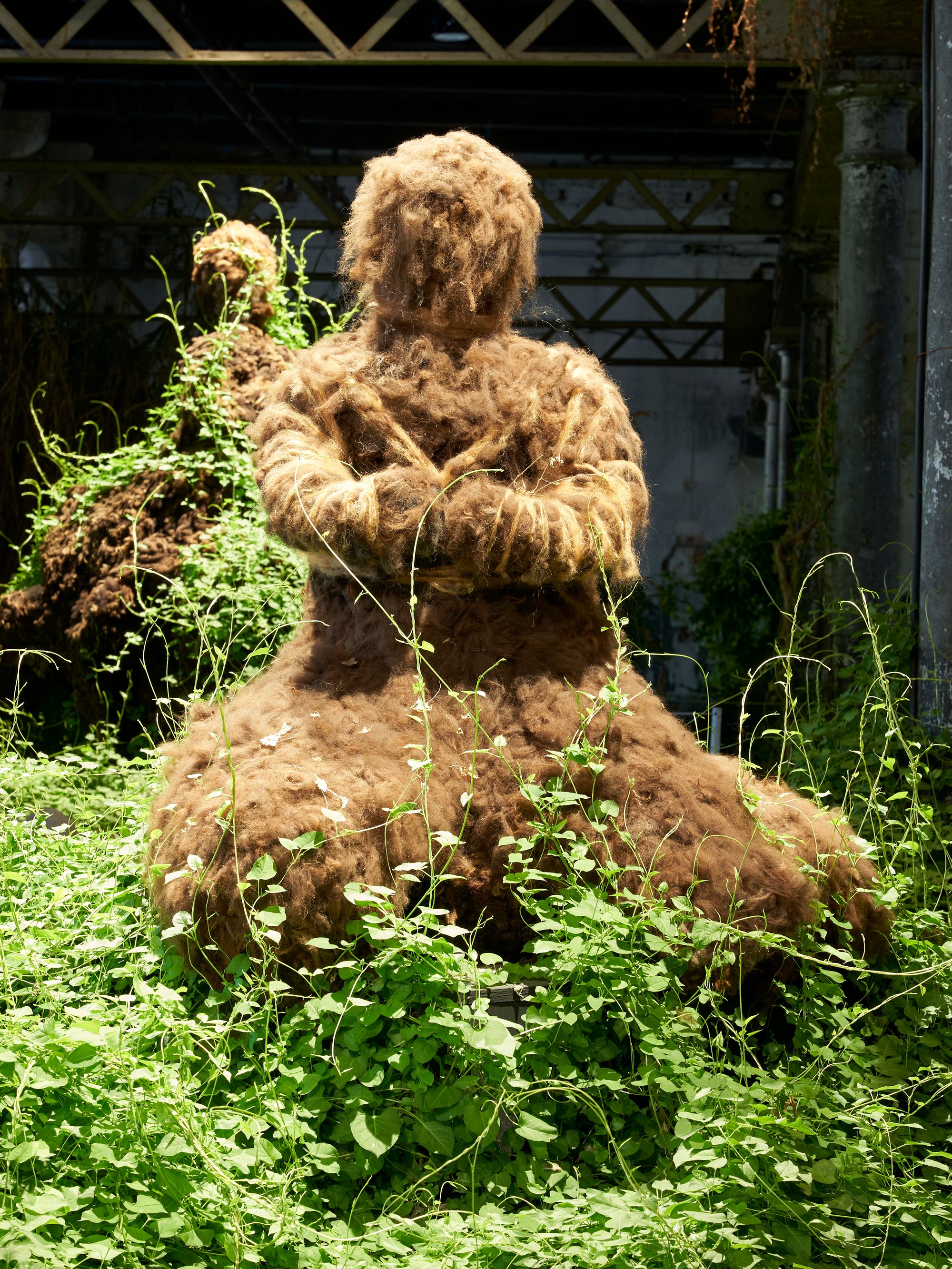
For the 2022 Venice Biennale, Okoyomon created sculptures among sugar cane and kudzu, pointing to fissures of ecology and economy in the history of the transatlantic slave trade. Photo courtesy of the artist.

Precious Okoyomon photographed by Davit Giorgadze for PIN–UP
Halfway through our conversation, just as Precious Okoyomon was telling me what will happen after the world ends, our Zoom call cut out and they abruptly disappeared from my computer screen. The Nigerian-American artist had prophesied a collective ego death, which seems like the end of the road. But the wonder of the 29-year-old’s practice, which spans installation art, poetry, and food, is that they can turn something as terminal as the apocalypse into fertile ground for growth. Okoyomon is unafraid of death: they hung stuffed animals from nooses attached to the limbs of a small tree for 2018’s Making Me Blush at Miami’s Quinn Harrelson/Current Projects; incinerated kudzu, the invasive southeast-Asian vine that blanketed the American South, in an attempt to repair post-slavery soil at their 2021 installation at Performance Space New York and at the 2022 Venice Biennale; and recently created a landscape of sculptures and resilient native plants on the roof of the Aspen Art Museum. But Okoyomon tempers their often morbid, decaying installations with a profound sense of care and humor. In their world, angels, death, rebirth, soil, flowers, and poison are linked together in one endless spiral, an ontological chaos in which we must learn to play.
Rachel Hahn: What’s new with you?
Precious Okoyomon: I’m getting ready for shows. I have one in Japan I’m really excited about: for the Okayama Art Summit, curated by Rirkrit Tiravanija, I’m making an insanely giant stuffed animal, 20-feet tall, in an abandoned swimming pool. It’s going to be stuck in a hole, its butt up in the air with flowers peeking out of it. I also recently went to Aspen to close up my show there, a project I worked on for almost two years. It was interesting to be somewhere that long, because you really get to know the community and can be really grounded in it. I planted a garden on the Aspen Art Museum’s roof using plants native to the area — things that didn’t have space to grow, but might have if Aspen was allowed to just be what it was. Doing this really simple thing opened up more space for all of these pollinating ecosystems. And I built up my sculpture practice out there. In the first garden iteration I did, I made a 10-foot-tall concrete angel, and I never worked in con- crete again. And then, for winter, I made an oven, and I’ve never made an oven again. This summer, I made a clay sculpture. I made my own clay. I learned all these new materials. And I’m going to do a ceramic residency this fall. It was a really cool exploration in learning to play, grow, and build.
So it was about having time, which is an important factor in much of your work.
Yes, it’s a huge part of my work — having things change and evolve and time being a placement in that. I see time as part of my medium — creating that slow time and recognizing that things are always in constant flux. My collaborator Gio Escobar [of New York music collective Standing on the Corner], who I work on the music with, was just at my Venice installation last week. He said there was a whole ecosystem in there, with mushrooms growing. I didn’t plant those — time does its own thing. It’s the world doing its thing. And that’s always so grounding and humbling for me.
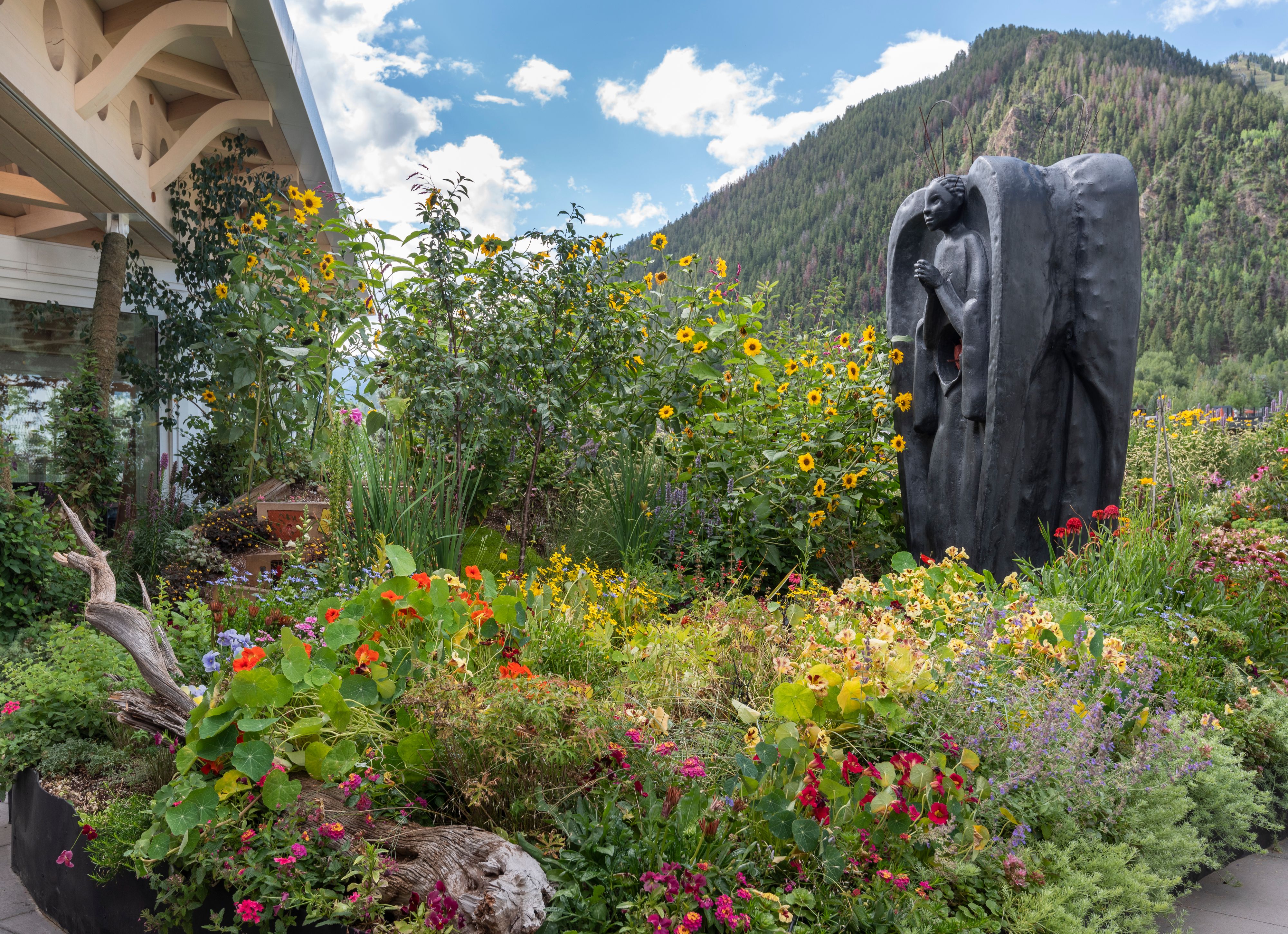
From June 2021 through September 2022, Okoyomon transformed the Aspen Art Museum rooftop for their exhibition Every Earthly Morning the Sky’s Light Touches Ur Life is Unprecedented in its Beauty. In collaboration with local growers, Okoyomon fostered seasonal bio- spheres of indigenous and invasive plants irrigated by a stream of black algae water. With local ceramicists, Okoymon crafted large-scale “angel protector” sculptures and musicians, poets, and others activated the environment. Photo courtesy of the artist and the Aspen Art Museum.
Presumably you always have some idea of how your installations will turn out, but when have you been surprised at how things evolve?
My installation at the Museum für Moderne Kunst in Frankfurt really surprised me. Because of COVID, no one was allowed in there for seven months, except the museum crew who watered the plants. When I came back, it was wild — there was so much life it shocked me. The fact that it created its own world was really trippy to me. All these special beetles were in there, all these snails. All this life found its way in there and cultivated its own space-time. So the work is constantly surprising me by evolving and just working on its own time-portal.
Does that sense of constant change ever make you feel out of control?
No, if anything that’s the miracle of the work: I have the ability to create a portal space and then enjoy the surprise. I like to work with materials that constantly humble me, that I can’t control. I get joy out of not being in control. It’s like a premature death pipeline. I don’t get to shape the work. In fact, it’s constantly reshaping me. Venice was interesting, because I was working with kudzu, which I have a deep entangled relationship with, and sugar cane, which I was always drawn to — it was a staple of my childhood. Those two plants have really been playing out their own little battle in that room. The kudzu just wants to swallow the sugar cane and I’m doing everything in my power to keep them both surviving and thriving in the same space. We have to do a little light pruning, or else the kudzu would crawl out the windows. So sometimes I do cultivate.
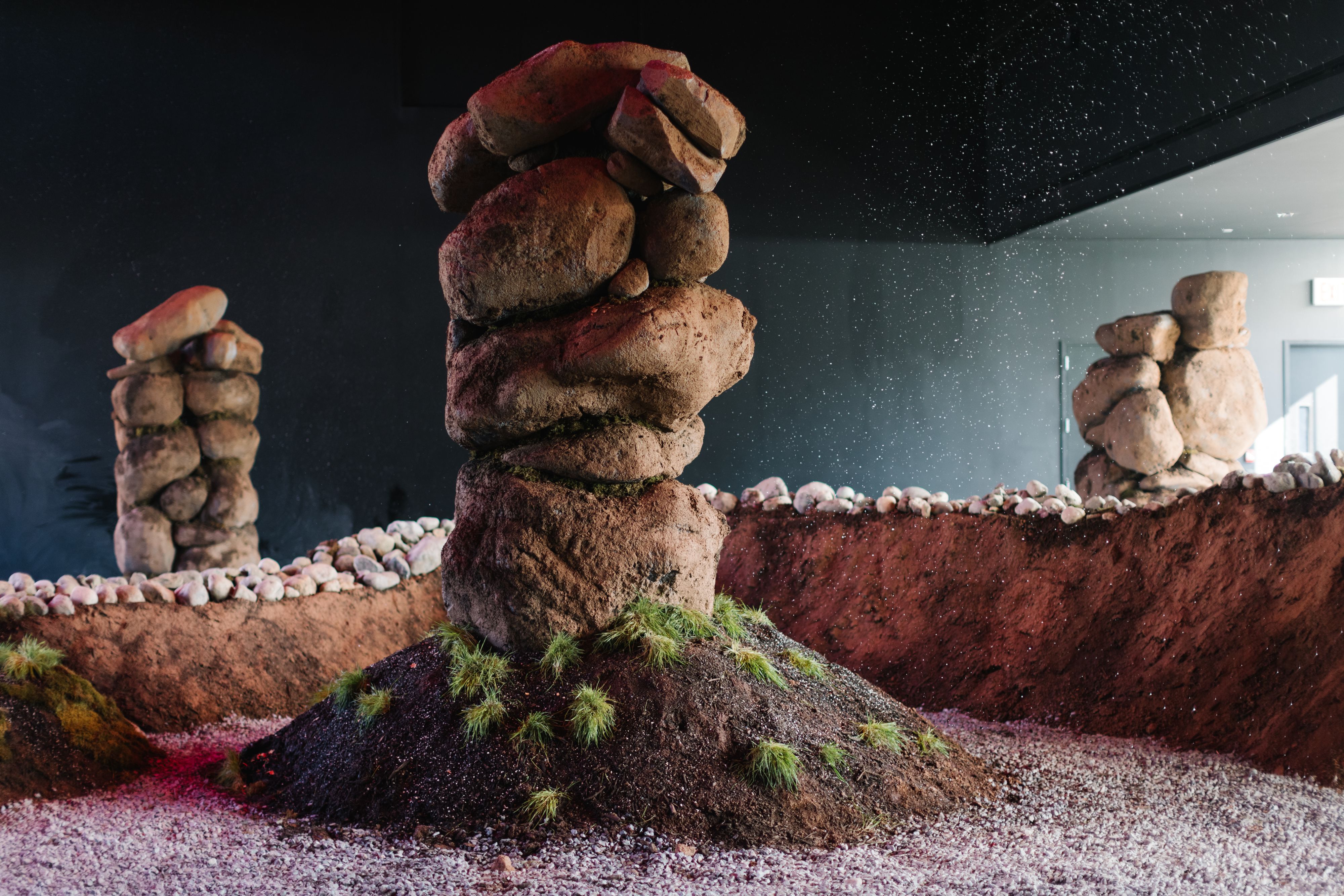
At Okoyomon’s 2021 exhibition at Performance Space in New York, visitors were invited to sit or lie down among gravel ground, and cairn-like mossen spires, and weaving dirt mounds. With algae, wildflowers, and ladybugs among the listed materials, so too was ash — the burned remnants of kudzu plants, an invasive species the artist repeatedly uses for their installations. Photo by Da Ping Luo, courtesy of the artist and Performance Space New York.
When did you first encounter kudzu?
It’s a plant I’ve always been fascinated by. When I was growing up, my mom had a really beautiful garden in her backyard. Nigerians love to meet up at prayer festivals, and I remember we went down to Georgia for one with my aunts, and that’s when I discovered kudzu. I stole a cutting and brought it back to Ohio and put it in my mom’s garden. I was 15 or something. And it grew so fast. It wraps around everything. I’ve always been really entangled with nature from a very young age, but at the same time it’s the chaos of nature, this mysterious force — I’m really drawn to things that have a certain monstrosity to them. When I started working with sculpture and thinking about objects, I never imagined them as separate from nature. A few years ago, I worked with a community garden in East New York where I had a little plot. It was a very cute time in my life — I wasn’t really making art, my garden was my art, and no one really knew about it. It was just my little garden of poisonous plants. In a weird way, I’d always wanted to make a garden of invasive and poisonous plants. It’s harder to get away with the poisonous plants these days. Every museum is always like, “There’s gonna be that one child who eats something and then we’re screwed.” So it’s safer to go with the invasive species.
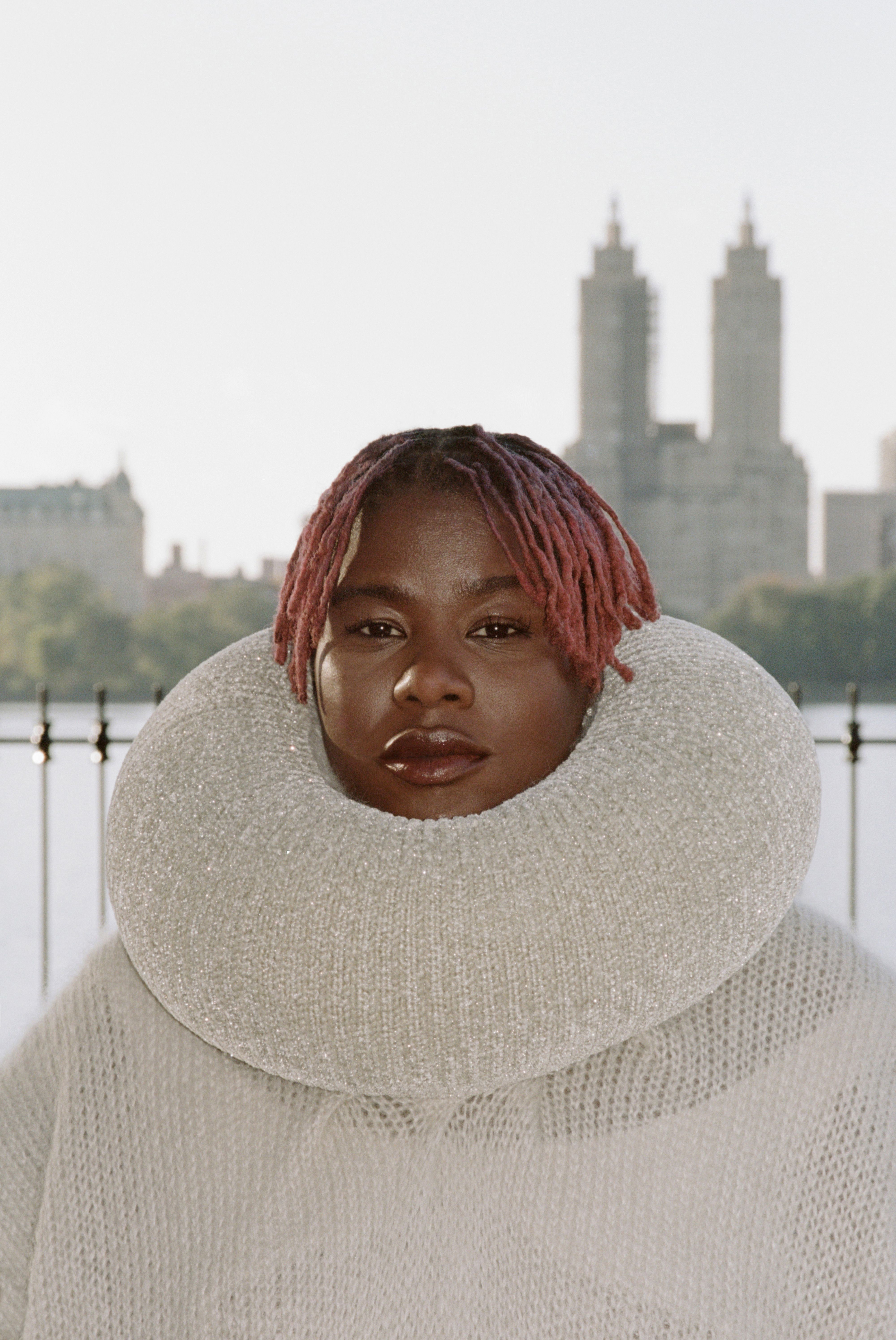
Precious Okoyomon photographed by Davit Giorgadze for PIN–UP
Your garden in East New York is a fairly small-scale. How do you approach the much larger-scale installations you’ve done, like those at Performance Space or the Venice Biennale? Is there a difference or are the same thought processes at play?
With the East New York Farms project, the community gave me a very nice soft landing into New York. It was a lot about being in a big city but still getting to play in the soil and grow fresh fruit and vegetables. I kept bees. It was lovely. It wasn’t a big transition to go from having this small garden to creating something that’s for a bunch of people. It’s just a bigger garden for more people to play in. The ultimate dream is a forest. I’m already working on it. But that will be the project for my 30s. I can’t say too much, but just know it’s in the works.
How would you intervene in a natural environment of that scale?
It’s mostly a project of migration and connection. I want to make one in London and one in Lagos, sister cities of Nigerian migration. And I want to make these really intentional forests in places that could use one, with these really special quick-growing trees. And I want to make these dream houses where you can go record your dreams — that’s a big part of my practice right now. I’m trying to create these spaces of healing within the forest. But this is at least five years away. I think it’s an interesting way to view land art, which is usually so based in thinking you can control the Earth, or that there’s something you have to do to change the Earth’s beauty, that needing to interrupt something, like Robert Smithson’s Asphalt Rundown in Rome — just pouring asphalt down a hill. I’m thinking of different ways of intervention.
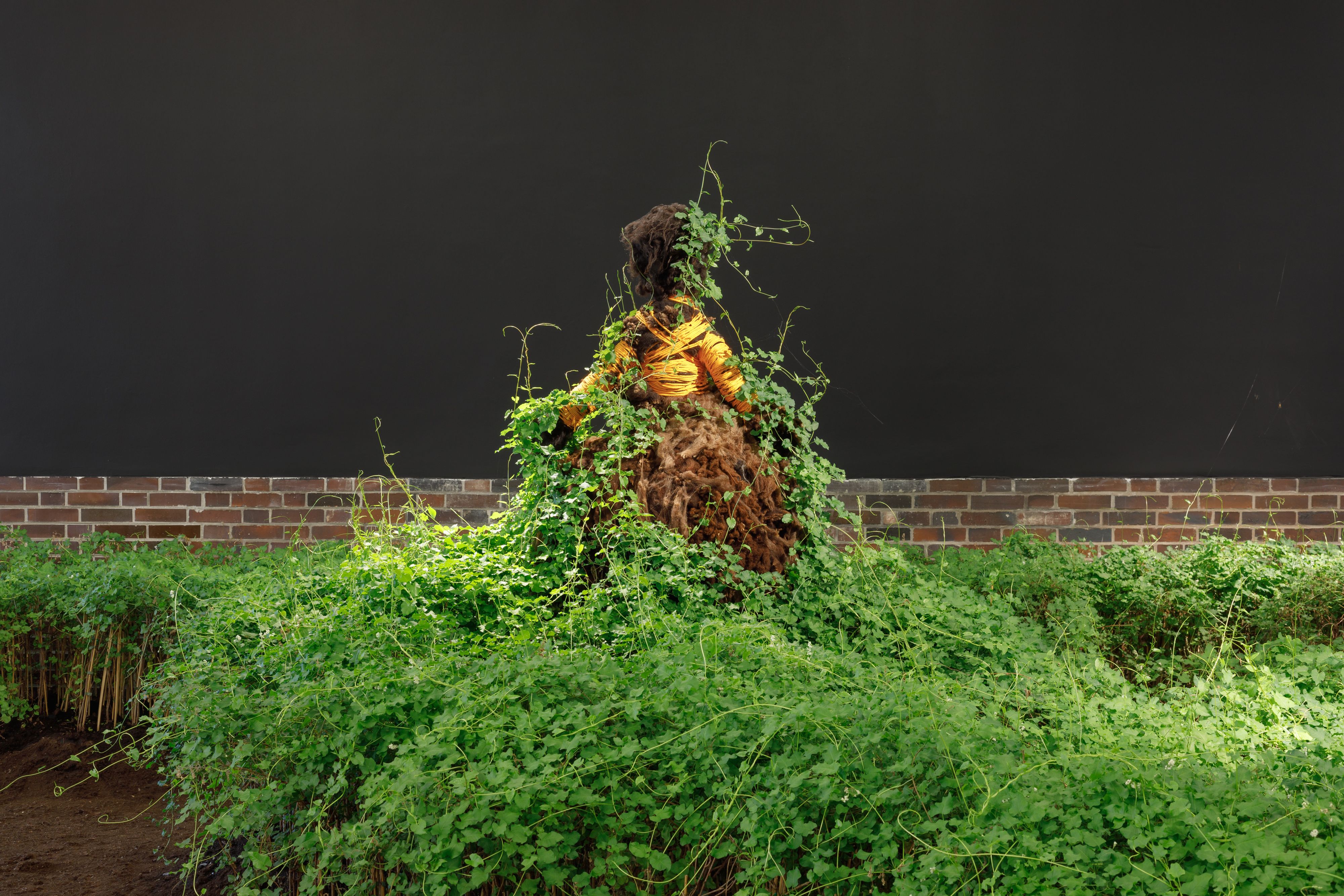
Okoyomon worked with the kudzu vine for her 2020 installation Earthseed at Frankfurt’s Museum für Moderne Kunst. Photo by Axel Schneider, courtesy of the artist and the Museum Für Moderne Kunst.
Where does your desire for chaos and unfettered growth come from?
I feel like that’s just like my modality — an unfiltered chaos of constant change and a direct monstrosity into a new portal opening. I don’t want anything that has come before. Let the kudzu eat everything and we’ll see what can grow under, grow over, grow on top, build in between. I think my childhood — this mixture of an extremely Christian upbringing while being allowed to be truly unfiltered in nature — gave me a deep hunger for chaos and play. I’m urgently hungry to create new things I’ve never seen or felt. I want constant opportunities for people to rediscover themselves and always be surprised by the miracle of the world. I’m terribly bored of the world the way it is, I’m like, “This can’t be it!” So how do we constantly reform and restructure into new things? This can only be one tiny crack in all the other multiplicities of cracks we have to make to break the thing. So the chaos is just a tiny fracture in the neurological semiotics of it — then we’ve got to add the labor of love and the care and the healing. We need all the mixtures of play in there. For me, that’s the practice — the constant buzzing of the chaos. The chaos is my music.

For the 2022 Venice Biennale, Okoyomon created sculptures among sugar cane and kudzu, pointing to fissures of ecology and economy in the history of the transatlantic slave trade. Photo courtesy of the artist.
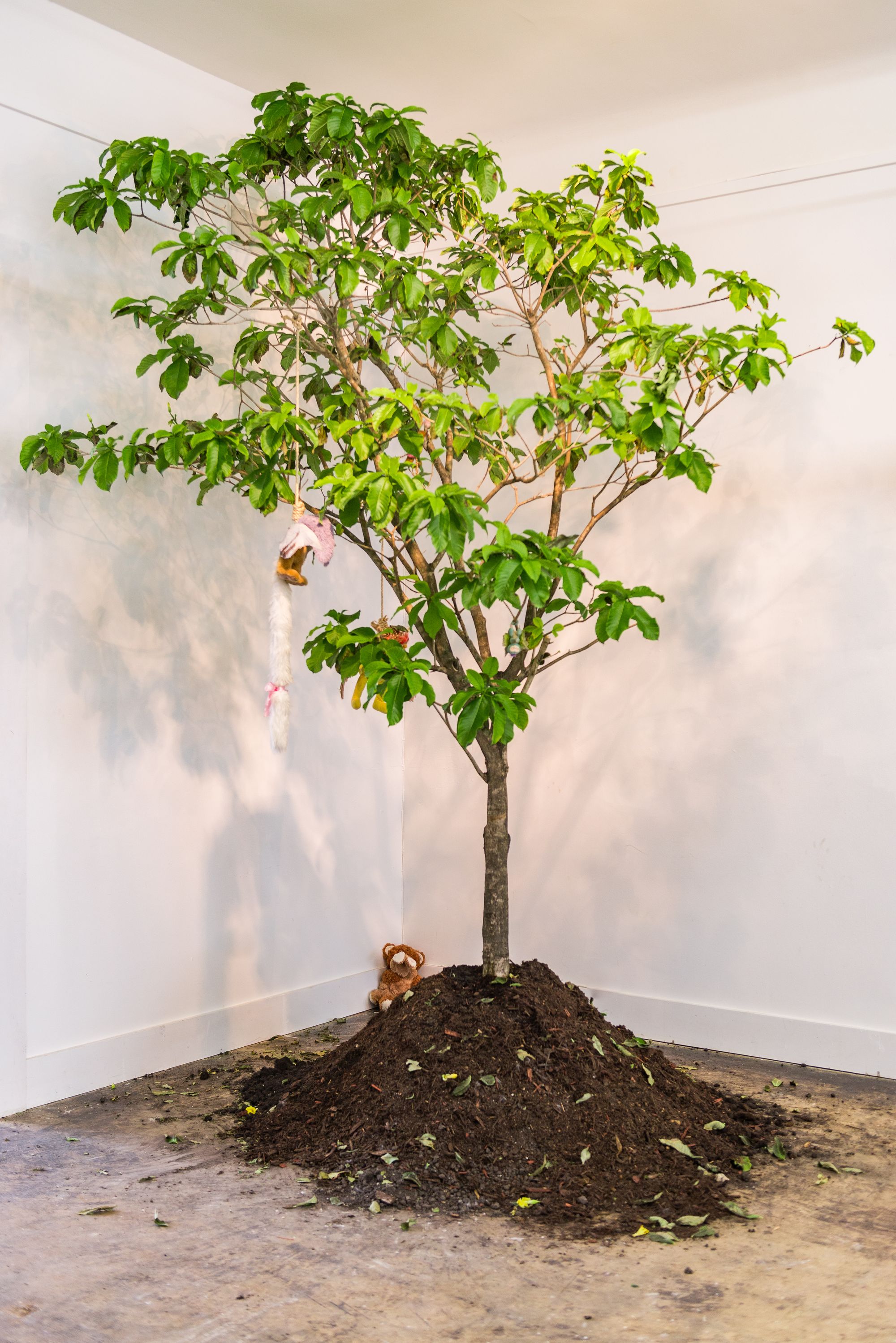
MAKING ME BLUSH at Miami gallery Quinn Harrelson/Current Projects (2019) was a collaborative effort between Okoyomon and the artist Puppies Puppies. The pair arranged a kaleidoscopic selection of objects in the gallery, including a pear tree, microscopes, underwear, bones, a water cooler, a bear cos- tume, and radioactive isotopes. Photo by George Echeverría, courtesy of the artist and Quinn Harrelson Gallery.
Decay and death are a big part of your work. Are you drawn to them because you’re afraid of them?
Is that not the suffering of the human condition — the knowing of the death, but not knowing how to live in the structured time we have to actually be okay with the constant dying? Is death not part of the everyday? I’m just trying to remind people that, before the primordial anxiety of fear, there is love. The death is just the everyday. It’s okay. Everything is always dying. It’s not that big a deal. I’m just trying to remind people that the decay is actually okay. That’s just our primordial anxiety — get over it. Like, we have shit to do. Who cares?
Have you always felt that death was a part of the everyday, or is that something you had to get comfortable with?
I didn’t go to art school, I went to philosophy school for four years at this Great Books College in Chicago called Shimer. I didn’t want to go to art school. I didn’t know what I was doing with my life. It wasn’t like I was nihilistic or anything, but I didn’t really know what I desired. I just wanted to go somewhere and read for a few years, so that’s what I ended up doing. I studied pataphysics and I formulated my four years around eschatology. What do we do after the end of the world? I studied Black Marxism and postcolonial theory. I did a lot of research into Schopenhauer, like the deep suffering of the world. I found a lot of Bracha Ettinger. I got really into psychoanalysis and thinking about death as everyday life. Premature death vibes. This is the wave of thought I’ve ridden the last ten years.
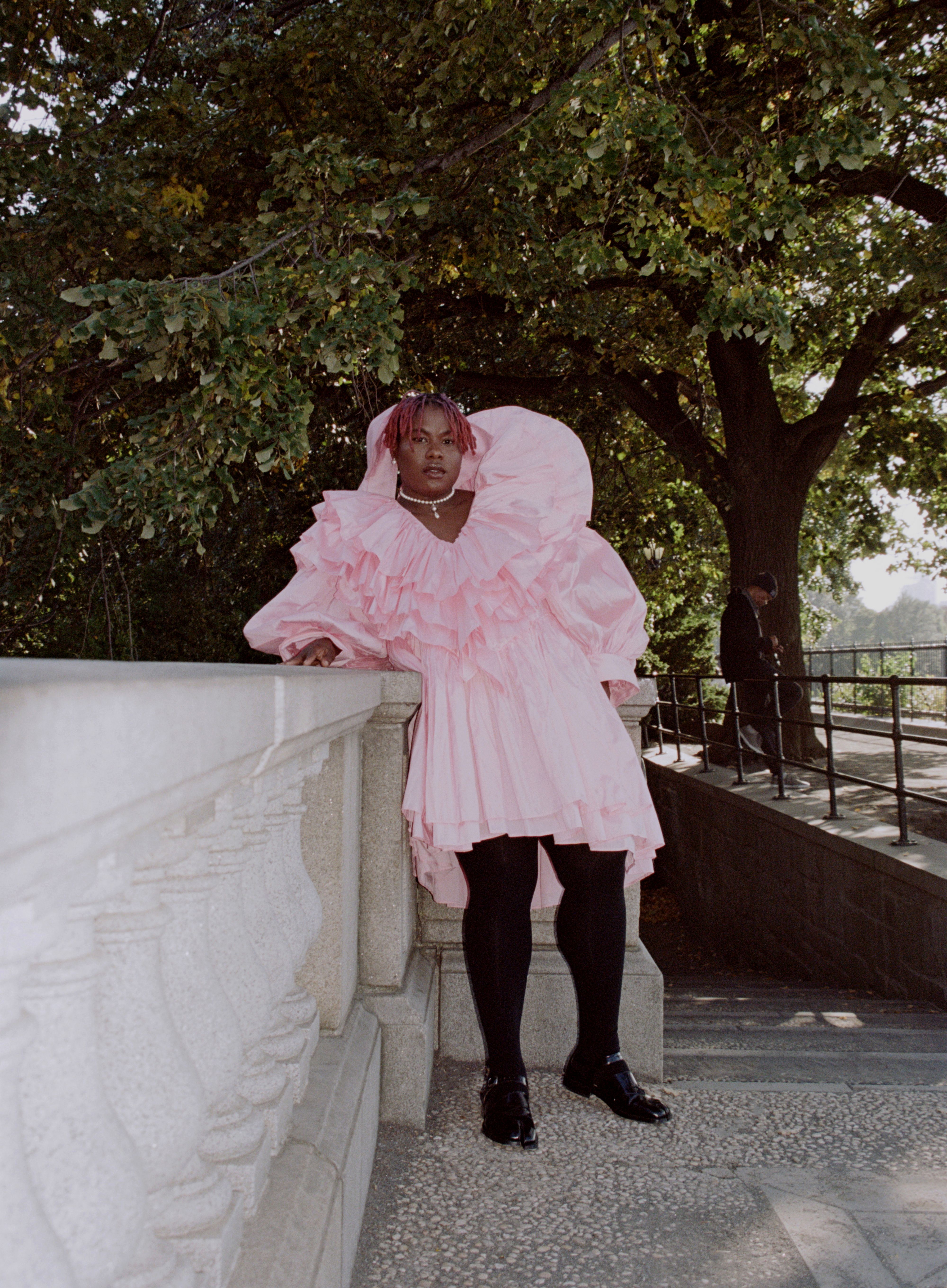
Precious Okoyomon photographed by Giorgadze for PIN–UP
So what comes next after the world ends?
I think society is in a really interesting place of not understanding the breakdown of how we choose to interact with each other — we don’t build bridges with each other or know how to form community. You could call it the state’s destruction of literal love and community building. I don’t think the world is constantly already ending for everyone every day — it’s more on a micro-level of just learning how to communicate with the people around us in a small, interpersonal way. And then we could start dissolving problems of the individual and get to the other stuff, because once we learn how to consent to the idea that we’re not really single beings — really what that means is just a fragilization of understanding where you and the other truly blend — it would probably rock a lot of everyone’s shit. My idea of how we actually fragilize would be to really slow down, like how everyone slowed down with COVID. It would just have to be a worldwide breakdown.
You’re trying to create something that’s filled with love by building these playful, fantastical worlds. How does history fit into that process of worldbuilding? Does it leave room for hope? Is it the basis for a speculative future?
History shows us the future more than it does the past. I feel humanity has a problem of not knowing how to create new things. We can only reproduce the same thing the human has produced before for millennia. But I want a new, different archive. We can learn from history. It can teach us which mistakes we shouldn’t repeat. History is there to guide us constantly. I think everything has a memory — especially soil. Soil memory is really important to me, especially how plants remember history. Kudzu grows in some of the most racist parts of America for a very specific reason. The soil did not forget. The plants did not forget. Archive memory is real. It’s how we learn from the angels of history guiding us into a world we actually desire and truly want to live in.
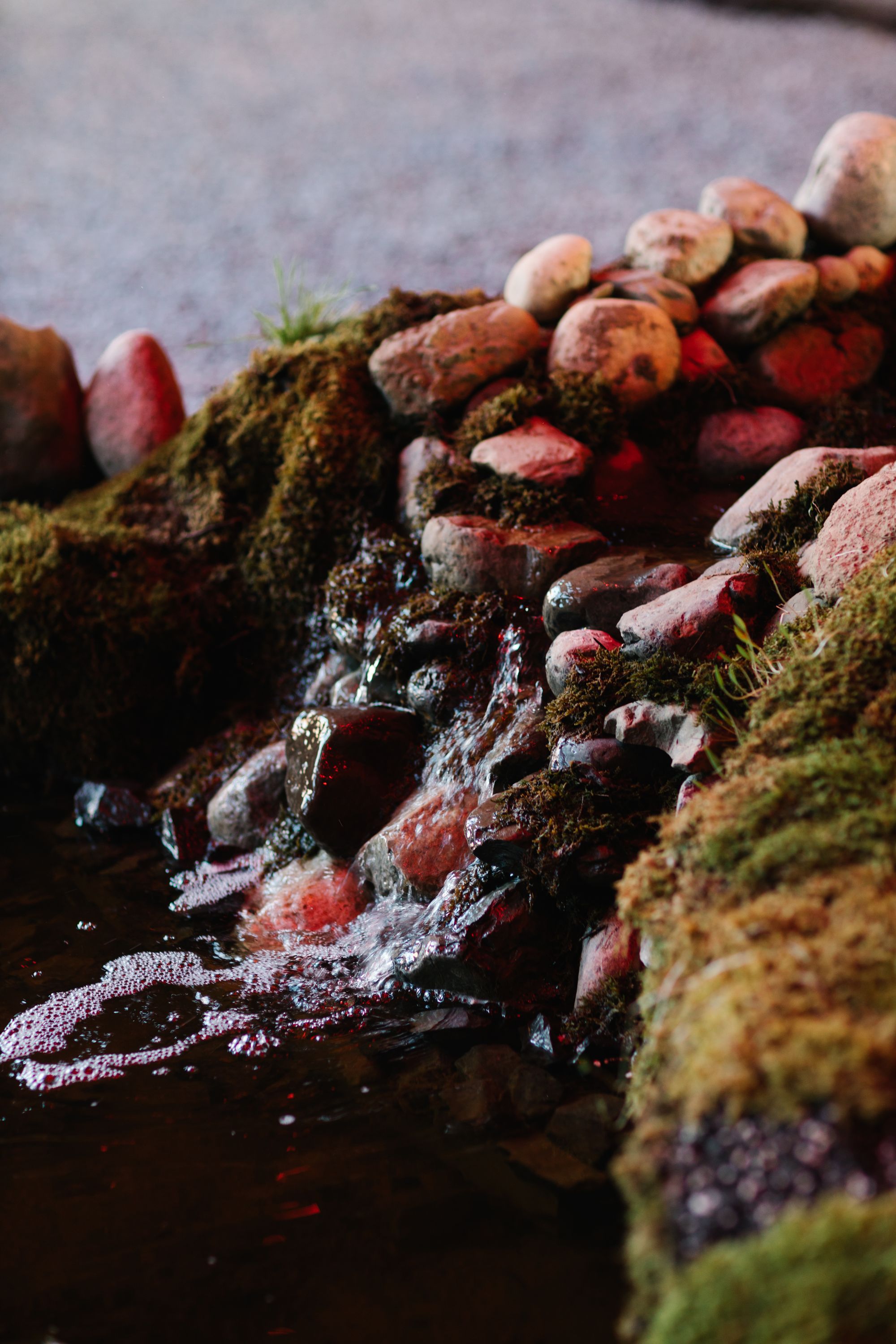
Detail of FRAGMENTED BODY PERCEPTIONS AS HIGHER VIBRATION FREQUENCIES TO GOD, Performance Space New York, 2021. Photo by Da Ping Luo, courtesy of the artist and Performance Space New York.
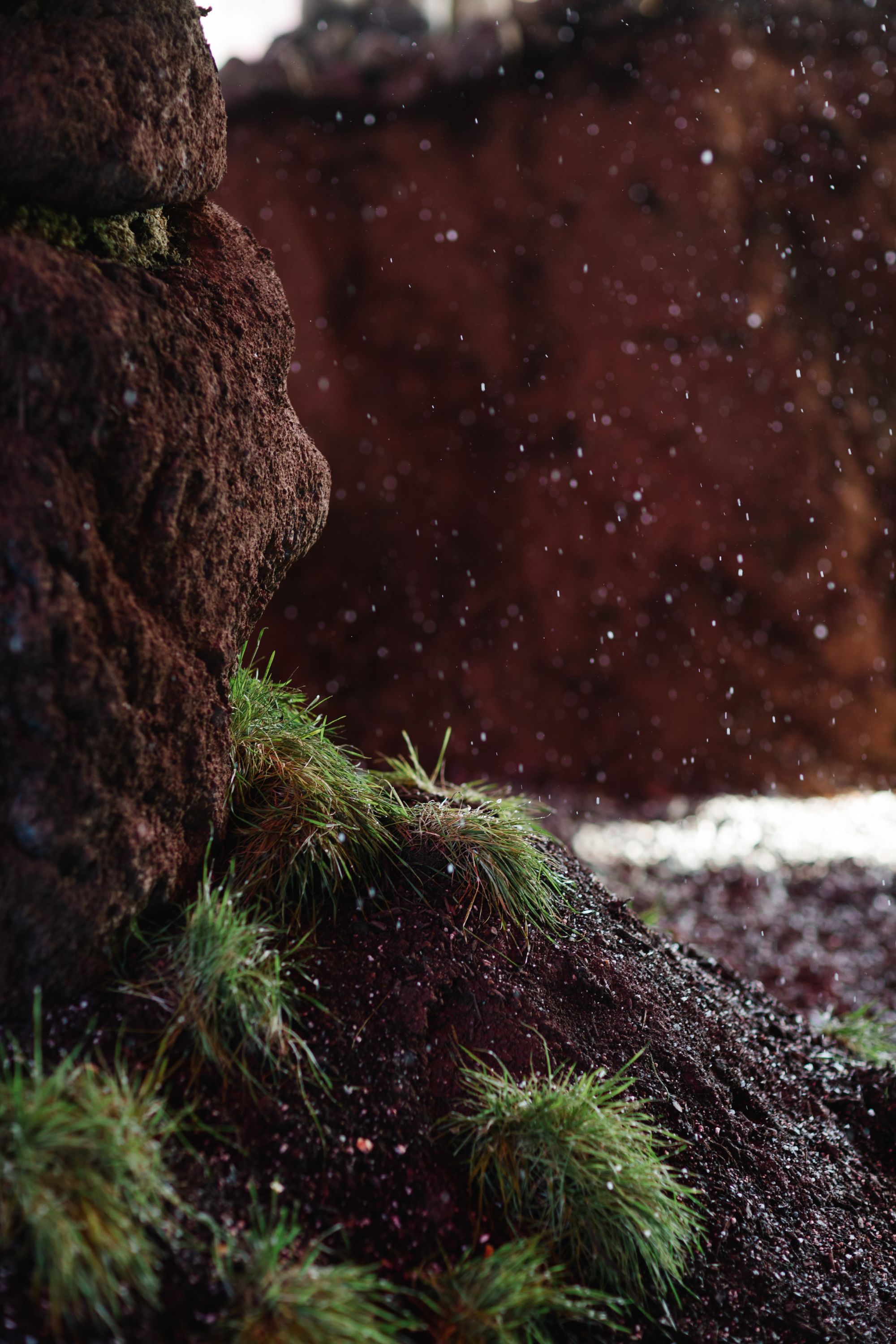
Detail of FRAGMENTED BODY PERCEPTIONS AS HIGHER VIBRATION FREQUENCIES TO GOD, Performance Space New York, 2021. Photo by Da Ping Luo, courtesy of the artist and Performance Space New York.
You also work a lot with food. What have you been cooking recently?
Food is a huge part of my practice — the nourishment of care and a labor of love. What is more caring than feeding somebody and changing the way their body exists? During COVID, it was really hard to do the type of public meals I used to do with my friends with Spiral Theory Test Kitchen. So we took a hiatus and just started cooking for ourselves. I recently did a thing up at [kitchen and gallery] Uncle Brother in Hancock, New York. And I’m going to cook with Rirkrit Tiravanija for the opening of our show in Okayama. I’ve been working with a soup kitchen, doing less outward-facing and more intentional things. But I want to do another big meal soon.
Which foods have you been experimenting with lately?
I really got into fermenting a few years ago. It’s all of the things I love — time, slow decay, and all of the flavor that comes out of there. So I’m slowly getting back into it. I’m really into slow-pickled flowers that you eat whole — like a nice fried pickled rose. I’m really into whole-flower meals.
What is your relationship to architecture? Is it something you think about when you frame your work?
I’m always thinking about architecture. In the last piece I did in Aspen I made a kind of nest inspired by Fulani grain houses, how they sweep up and are these kind of pointy witch houses. I started thinking of them as places of nesting and sowing seeds. And then I made a sound piece with my friend Gio about decay, decomposition, and becoming soil. You crawl into a grain hut, and the door is made from stuffed animals, and you listen to a meditation about soil. I felt really vulnerable making a piece like that, because it was very much like you were entering inside of me. I’m also preparing a big show in Austria at the Kunsthaus Bregenz, and I’m working with an architect to help me think about the spatiality of the building. I’m rethinking how to form the space by creating an insane dollhouse sort of situation. Architecture is a weird, slow love of mine, to be honest.
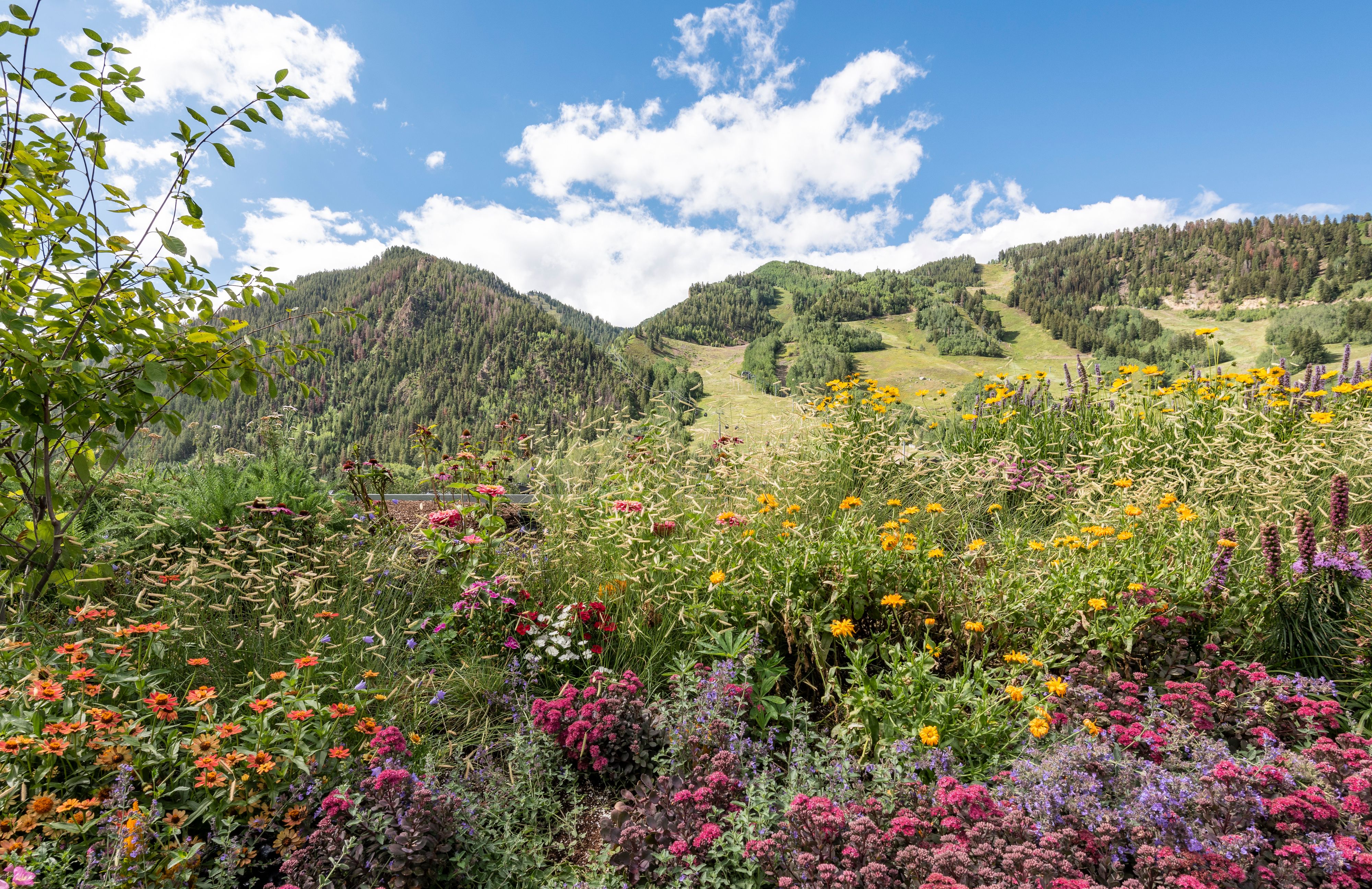
Precious Okoyomon, Every Earthly Morning the Sky’s Light touches Ur Life is Unprecedented in its Beauty, Aspen Art Museum, 2021-2022. Photo courtesy of the artist and the Aspen Art Museum.
Have you ever felt you needed to compromise your ideas when working with major institutions?
Nobody’s going to tell me I can’t do what I want to do. Ever. That’s just my vibe. You could not like it, but I have a portal I’m trying to open and you’re either down with it or you’re not. And if you’re not, you’re not at the table. It’s a good table I’m building. So if you don’t want to help me build the table, you usually don’t want to sit down with me. But I’ve been really blessed to work only with people who want to support the vision and to give me space to grow and play. I’ve been very lucky.
Besides your forest, what other spaces do you hope to transform?
I have all these crazy dreams about doing really absurd, unrealized projects. I want to spend a year teaching a dolphin a poem in North Carolina. I want to build a radio tower in the middle of the ocean. I want to build my archive of dreaming, where everyone can go and record their dreams. I’m so curious what Deleuze and Guattari were dreaming about. Why can’t I just go to the dream library and listen to their archived dreams? I’m so curious what so many people’s dreams were. It’s a robbery that I can’t listen to everyone’s internalized portals. There’s so much I want to manifest and there are a lot of spaces I really need to inhabit. Many of them I don’t know yet. They still have to come to me in my dreams.